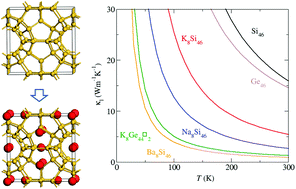The origin of glass-like phonon dynamics in binary Si and Ge clathrates-I
Abstract
Intermetallic guest filled host clathrate cages have been identified as promising materials for thermoelectric applications owing to their phonon glass electron crystal (PGEC) behavior. The vibrational dynamics of empty and guest filled stable host (Si and Ge) clathrates is explored using density functional theory based calculations. The role of the guests as well as the host in the vibrational dynamics of these clathrates is analysed. The empty clathrate cages are found to be harmonic crystals. However, filling of their cages with guest results in deviation from harmonicity, which is either due to imbalance of electronic charge (in Si clathrates) or due to softening of the framework bonds (in Ge clathrates). The increase in anharmonicity plays a crucial role in changing their scattering lifetimes and hence the lattice thermal conductivity. The lattice thermal conductivity of these compounds is calculated by modeling their phonon scattering lifetimes from the Grüneisen parameter, zone-boundary frequency, and group velocity of the acoustic phonon modes using the Debye Callaway formalism, which is found to be in good agreement with experiments.



 Please wait while we load your content...
Please wait while we load your content...